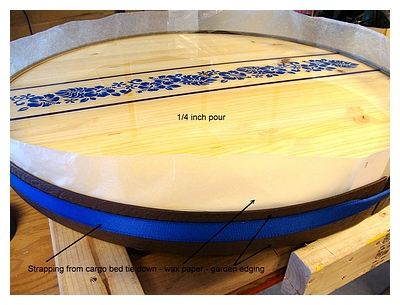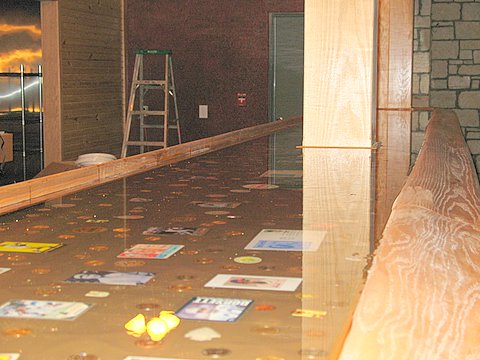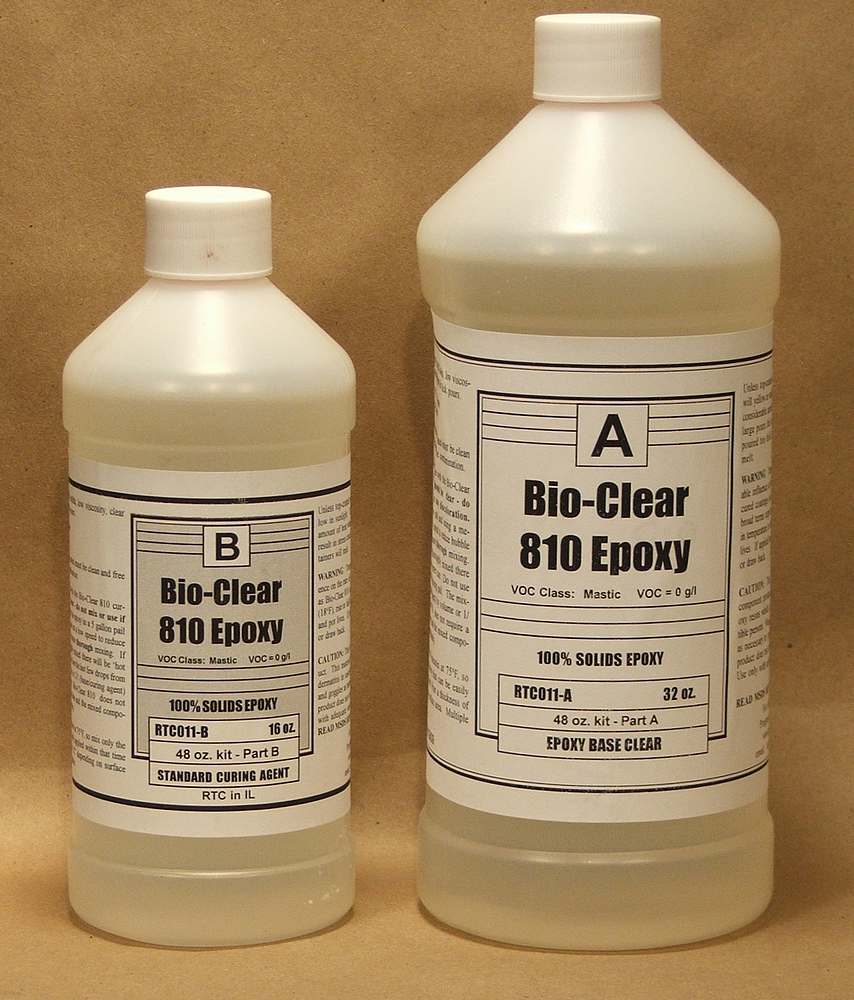
EPOXY QUICK FIND LINKS - COMPREHENSIVE
EPOXY RESOURCE WEB SITES - CLICK HERE
The Expert's Best Picks:
The Very Best Web Products - Best two part pour on epoxy - table - bar top
RATED BEST: pour on table bar top epoxy - Professional grade
Paul Oman - MS. MBA
A.K.A. “Professor E. Poxy”
epoxies since 1994
Member: NACE (National Assoc. of Corrosion Engineers)
SSPC (Soc. of Protective Coatings)
PRODUCT NAME ----- Bio Clear 810 (tm)
This product is featured on the GreatThings4u.com website
Another great Bar Top epoxy page EVERYTHING EPOXY SITE

epoxy table top pour
| Order this product by calling 603-435-7199 anytime or order online using this link: EPOXY NOW |
SELECTION CRITERIA ----- Just because the epoxy is clear doesn't make it a good epoxy for table tops and bar tops. A good bar top epoxy needs to be very thin to self level and reduce possible bubbles. All epoxies yellow in UV but a good bar top epoxy doesn't yellow quickly. It also cures slowly and evenly, without generating much heat.
Bio Clear 810 epoxy has an outstanding record with both professional and DIY table and bar top projects. See the links below.
The 'almost no yellowing' in this formulated epoxy sets it apart from folks selling raw, clear resin systems purchased in bulk and not specifically formulated for Table Tops and Bar Tops. One reason is that it is the only Cyclo-aliphatic based table top epoxy in the marketplace.
IF YOU DON'T USE CYCLOALIPHATIC BASED BIO CLEAR 810 YOU'LL REGRET IT BIG TIME. HERE'S WHY....
A commercial epoxy pour contractor recently used our Bio Clear 810 to replace a badly yellowed epoxy poured covered logo on the INSIDE floor of regional airport terminal with our 'almost no yellowing' Bio Clear 810 (cyclo-aliphatic epoxies to the rescue!)
This is a good example of why you want to use only a cyclo-aliphatic epoxy for your bar top. The other clear epoxies sold for table tops suffer from bad (excessive?) yellowing (and I bet they don't even mention it on their web sites).
Don't be like the first contractor that just poured some cheap clear epoxy over the airport logo and thought they did a good job. It looked fine to start with and the contractor made a few extra dollars using generic clear epoxy. Too bad. The airport was lucky they could redo their badly damaged cheap epoxy mistake. Most folks cannot redo their special poured epoxy table top.
NOTE: Because of the yellowing, it is generally not a good idea to have a poured epoxy table / bar outside in the sun, but if you do - use our cycloaliphatic epoxy and keep it covered when not in use.

commercial bar with bio clear 810 pour on epoxy top
PRODUCT DATA SHEET (PDF) ----- CLICK HERE best pour on epoxy .
| BIO CLEAR 810 | xx | EMAIL US | xx | |
| air shippable | cycloaliphatic system | xx | ||
| no nonyl phenol | xx | epoxy adduct system | ||
| multi curing agents | bulk pricing | |||
| solvent free | xx | no Calif. sales | ||
| 2 part epoxy | xx | 2 part poly | ||
| apply underwater | bubble breakers | xx | ||
| favorite(s) product list | data sheets | xx | ||
| PACKING - jugs/bottles | xx | PACKING - cans | xx | |
| find in non marine cat | xx | find in marine catalog | ||
| PRICES/ind/commercial | xx | PRICES/marine section | ||
| BUY online | BUY online | xx | ||
| home page | xx | contact page | xx |
WEB INFO SHEET ----- CLICK HERE best pour on bar top epoxy .
MSDS ----- CLICK HERE best table top epoxy msds .
PURCHASE LINK -----
No Sales Tax applied. Save Money, you're shopping in Tax Free New Hampshire
| Order this product by calling 603-435-7199 anytime or order online using this link: EPOXY NOW |
OTHER LINKS ----- all about poured epoxy bar tops and table tops - examples and info CLICK HERE
The "EPOXY GURU" explains the best treatment for a wooden outdoor table. It is NOT a poured-on epoxy - Table-GURU
| Order this two part EPOXY Product NOW |
|
"OK...thanks for the personal touch. And for such an informative website. The navigation took me a while to grasp, but I really appreciate all the credible, helpful information you provide. This is my 3rd or 4th order over the years and I give you a A or A+ grade on all of it. I'm a nit-picking former Polaris nuclear missile targeting and firing guy so you don't get a good grade from me unless you are on target!" -- Dave 7/14 call for info/help/ordering anytime 603-435-7199 |
 |
Bio Clear 810 pour on table/bar top epoxy Sampler Kit New to pour on epoxy projects? Best approach is to order our 48 oz Bio Clear 810 sample kit. Get past the learning curve and gain some experience up front. Don't tackle your Big Project with products you have no experience using - too risky! This product is featured on the GreatThings4u.com website. CLICK HERE to see these products in our online catalog (special purpose epoxies section). |
|
FIND THIS/THESE PRODUCT(S) IN ONLINE CATALOG PAGE AND ONLINE STORE FRONT |
DID YOU KNOW...
Epoxy coatings are used because of their
outstanding chemical resistance, durability, low porosity and strong bond
strength.
Epoxies consist of a ‘base' and a ‘curing' agent. The two components are mixed in a certain ratio. A chemical
reaction occurs between the two parts generating heat (exotherm) and hardening the mixture into an inert, hard
‘plastic'.
Epoxies yellow, chalk (or more commonly least lose their gloss), in direct sunlight (UV). The yellowing can
be a real problem. For pigmented epoxies select colors that are dark or contain a lot of yellow (such as green).
Even clear epoxies will yellow and cloud up. Often epoxies are top coated with latex or urethanes that will retain
their color and attractive gloss. This is particularly true if color coding or matching company colors is important.
Epoxies will harden in minutes or hours, but complete cure (hardening) will generally take several days. Most
epoxies will be suitably hard within a day or so, but may require more time to harden before the coating can be
sanded.
By their nature, epoxies are hard and brittle. Additives can be added to epoxies that make them less brittle,
but generally at the loss or reduction of other positive epoxy properties such as chemical resistance.
Other clues of cheap epoxies include ‘induction time' (after mixing the two components the mixture must sit
for several minutes to ‘self cook' before being applied).
The best time to recoat epoxy is within about 48 hours after the initial coat. Because epoxies take days to
reach full cure, a second coat applied shortly after the first coat will partially fuse to the first coat rather
than forming a simple mechanical bond.
End users can thicken epoxy with many things, Tiny glass spheres, known as micro-spheres or micro-balloons
are commonly used. Besides thickening, their crushable nature makes sanding the hardened epoxy easier. On the downside,
they work like tiny ball bearings, resulting is sagging and slumping. Another thickener is fumed silica (a common
brand name is Cabosil (tm)) which looks like fake snow. About 2 parts fumed silica with one part epoxy will produce
a mixture similar in texture and thickness to petroleum jelly. Micro-spheres and fumed silica can be combined together.
Fisheyes are areas on a painted surface where the coating literally pulls away for the substrate leaving a coatingless void or fisheye. Often fisheyes are caused by surface contaminants such as a bit of silicon, wax, or
oil. I have also seen them on clean plywood where epoxies paints have been used as sealers and the problem might
be due to uneven saturation (soaking-in) of the epoxy into the wood. Surface tension plays a big part in fisheyeing.
There are some additives that can be mixed into the epoxy that will reduce surface tension. Likewise, on wood,
applying several coats of solvent thinned epoxy, instead of one coat of unthinned epoxy, seems to work well. Applying
a thick coat of epoxy over a contaminated fisheye surface will bury the fisheye but expect the coating to peel
away in the future. As a rule of thumb, always suspect some sort of surface contamination as the primary cause
of fisheyeing.
Adding a bit of solvent to a solvent based or solvent-free epoxy is something that most manufacturers would
not officially approve of and something that might not work with all epoxies. However, it can be done (unofficially)
with the epoxies I deal with. Adding solvent to these epoxies will: 1) thin them out; 2) increase
pot life; 3) allows
them to flow off the brush/roller a bit more smoothly; and 4) perhaps allows them to ‘soak-in', penetrate, or may
be soften, the substrate just a little bit. Not change is visible in the epoxy unless 12% or greater solvent is
added. With that amount of solvent, the epoxies no longer cure with a glossy finish.
It is best to use epoxies with a mix ratio close to 1 to 1 as opposed to something 4-1, 5-1, etc. because errors
in the mix ratios can be more pronounced with the latter. That said, no matter what the mix ratio is, some epoxies
are more forgiving of mix ratio errors than others. One ‘trick' of epoxy vendors with odd or very sensitive mix
ratios is to sell calibrated pumps that disperse the epoxy components in exact amounts.
How Thick? How thick should your coating be? Economics play a major role in determining how much coating to apply. One U.S. gallon contains 231 cubic inches. That's only 1.6 cubic square feet of surface at one inch thick and that's also assuming a solvent-free product. If the product is 25% VOC (i.e. 25% solvent) then dry thickness/coverage will be 25% less. Again, assuming a 1/4 inch thick coating (250 mils) maximum coverage will still be only 6.4 square feet per gallon. A solvent-free (100% solids) epoxy coating applied at 16 mils will cover 100 square feet per gallon (note: the wall paint in your office is probably 2-4 mils). While thick coatings sound like a good idea, they use so much product that they must be made very cheaply so that coating 1,000 or 10,000 square feet can still be done at a competitive price. A high quality, fairly expensive product with a coverage rate of 100 sq. feet or more per gallon, on the other hand, will have a low enough cost per sq. foot to provide both economy and top quality.
need to learn more about epoxies??
--- visit these third party sites ---
(EVERYTHING-EPOXY.INFO --- Intro to basic epoxy resin types )
also visit the EPOXY GURU
|
ONLINE PRODUCT CATALOGS PROGRESSIVE EPOXY POLYMERS, Inc
A COMMERCIAL - INDUSTRIAL -
PROFESSIONAL PRODUCT
You won't find these products, or products like it, in
a general purpose, mass market, consumer, DIY, box store or flashy
marketing company website.
|
|||
|
ONLINE STORE Purchase Here ------ or CALL 603 435 7199 ------ HOME PAGE |
|||
|
Marine Catalog |
|||
* home
page of marine catalog section (blue background)
|
|||
| Section One MARINE - CLEAR EPOXIES Section Two FILLERS THICKENERS ADDITIVES Section Three THICKENED EPOXIES - EPOXY PUTTIES, ETC. Section Four EPOXY PAINTS (barrier coats) Section Five URETHANES AND NON-EPOXY COATINGS Section Six NON-SKID DECK COATINGS Section Seven MARINE REPAIR PRODUCTS Section Eight MISC. MARINE PRODUCTS |
|||
|
MASSIVE BOAT HOW TO - ISSUES - HELP WEB LINK SITE |
|||
|
Residential / Commercial / DIY Catalog |
|||
* home
page of residential/commercial catalog section (brown background)
|
|||
|
Section A EPOXY PAINTS Section B FLOOR EPOXIES (regular and non-skid products), SEALERS, ACCESSORIES Section C THICKENED EPOXIES - EPOXY PUTTIES, ETC. Section D CLEAR EPOXIES Section E NON-EPOXY PAINTS COATINGS SEALERS Section F MIX-IN ADDITIVES Section G OTHER PRODUCTS Section H SURFACE PREPARATION PRODUCTS Section I MISC. ACCESSORIES |
|||
|
WEB EPOXY FLOOR ISSUES LINKS SITE --- WEB EPOXY REPAIR LINKS SITE |
|||
|
top selling favorite products for your every need Buy Talk Chat Support EMAIL or 603 435 7199
American manufactured, distributed, and sold epoxies and coatings. Your business helps small American Family Businesses - Thank You! |
Internet Epoxy Confederation (IEC) Your connection to SAFE, DEPENDABLE, EXPERT epoxy web sites, vendors, products, links VISIT IEC NOW at Epoxyfacts.com
|
The Very Best Web Products - Best two part pour on epoxy - table - bar top
RATED BEST: pour on table bar top epoxy - Professional grade
#####